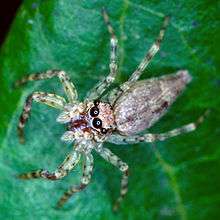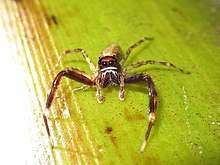Helpis minitabunda
Helpis minitabunda is a jumping spider. A widespread species in the east and south east of Australia and in Papua New Guinea, usually found on foliage in moist areas.
| Helpis minitabunda | |
|---|---|
 | |
| female | |
 | |
| male | |
| Scientific classification | |
| Kingdom: | |
| Phylum: | |
| Class: | |
| Order: | |
| Family: | |
| Genus: | |
| Species: | H. minitabunda |
| Binomial name | |
| Helpis minitabunda L.Koch 1880 | |
| Synonyms | |
| |
Common names include threatening jumping spider and bronze jumping spider. The specific epithet minitabunda is derived from Latin, meaning "threatening". The male may show fearless or threatening behaviour when approached.[1][2]
Unusually for spiders, the male is larger than the female. Male body length to 10 mm, females to 8 mm. The front two pairs of legs are particularly long. The male head has a flat topped caput covered with creamy white hairs. Below are large protruding chelicerae. The demeanor of the female is more cryptic than the male. The pre-mating courtship dance between male and female may last from two to three hours.[3] Helpis minitabunda is an invasive species in New Zealand.[4]
References
- "Helpis minitabunda (L. Koch, 1880)". Atlas of Living Australia. Retrieved February 1, 2020.
- "Aussie Bronze Jumper - Helpis minitabunda". Brisbane Insects. Retrieved February 1, 2020.
- McKeown, Keith C. (1952). Australian Spiders. Australian Museum: Sirius Books. pp. 244–245.
- "Helpis minitabunda (L. Koch 1880) Threatening Jumping Spider". Arachne Australia. Retrieved February 1, 2020.
| Wikimedia Commons has media related to Helpis minitabunda. |